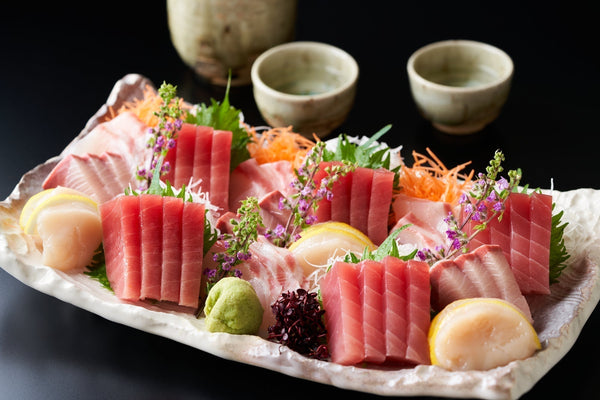
Jump to:
When learning about Japan’s food culture, I’ve learned to focus on what the Japanese people choose to do and – just as much – not to do with food.
While Italian cuisine is all about transformation – turning flour and water into endless pasta shapes, or grape juice into wine – and French cooking celebrates elaborate technique and culinary manipulation, Japan stands apart in its remarkable restraint.
And when we look at sashimi, we learn that the Japanese have the courage to – at just the right times and in the right settings – do almost nothing at all. Almost, of course.
I've spent years trying to understand this paradox: how the simple act of not cooking fish became one of the most sophisticated culinary traditions in the world.
What Is Sashimi & Why Is It Special?

The sashimi story begins with necessity (ancient fishermen preserving their catch) and ends with philosophy (the celebration of ingredients in their purest form). And of course, it's about the fascinating journey sashimi takes between these two points: how a basic survival technique evolved into an art form so refined that apprentice chefs spend years learning just to slice fish correctly.
Unlike its more famous cousin sushi, sashimi strips away everything – no rice, no nori, no additional ingredients. It's just pure, unadulterated seafood striving to attain the perfect form. Think of it as nature's ultimate minimalist dish, where there's literally nowhere for imperfections to hide.
What Does the Word "Sashimi" Actually Mean?
 Fun fact: the word "sashimi" literally translates to "pierced body" in Japanese.
Fun fact: the word "sashimi" literally translates to "pierced body" in Japanese.
Okay, so that’s not exactly the most appetizing translation!
But sashimi refers to the ancient practice of attaching the fish's fin or tail to the sliced meat to identify the species – a kind of early food labeling system, if you will.
In modern-day, Japanese cuisine, sashimi refers to raw fish that is sliced meticulously and plated with deliberate and artful arrangement.
Sashimi’s cousin is sushi, of course, which is raw fish that’s sliced to a certain thickness and served on a bed of vinegared rice. In the US and many other countries, sashimi is often served as an appetizer as part of a sushi meal or in other Japanese restaurants. But in Japan, the two have a somewhat separate relationship.
Before going into how it’s prepared and served (and where to eat it, surely), let’s take a step back and look at the history of sashimi.
A Brief History of Sashimi

Let’s go back to Japan's Muromachi period (1336-1573), when this whole story begins.
Picture yourself in a small fishing village, where fishermen have just brought in their morning catch. They discover something remarkable: if they slice the fish immediately and just right, it stays fresher longer and tastes incredibly better. Little did they know they were laying the groundwork for one of the world's most sophisticated culinary traditions!
What started as a practical preservation method gradually evolved into an art form during the Edo period (1603-1867). This was Japan's golden age of culinary innovation, when specialized knives were developed specifically for creating those perfect, paper-thin slices we admire today. It's fascinating to think that some of these knife designs have remained virtually unchanged for centuries.
Over time, sashimi has become a popular element in restaurants ranging from izakaya (Japanese pubs) to mid range restaurants in Japan, upwards to fine dining experiences such as kaiseki, omakase and even Michelin-starred restaurants.
Types of Sashimi
Sashimi isn’t just randomly sliced fish.
On the contrary, sashimi is a very deliberate culinary art form. At its core are certain types of fish and seafood, each carefully curated, selected, sliced and served with great intention – because that’s the Japanese way!
1. Tuna: Akami, Chutoro & Otoro

Let's start with what many consider the holy grail of sashimi: bluefin tuna.
If you're a sashimi newcomer, you might think tuna is just tuna, right? Oh wow, are you in for a treat! There are actually three main cuts, each with its own personality:
Akami: Lean part of tuna
Think of akami as the sophisticated older sibling of the tuna family. It's that deep, rich red meat that practically glistens on your plate. The flavor is clean and intense, with a firm texture that makes each bite satisfying.
Akami may very well be the perfectly tailored suit of the sashimi world – classic, reliable and always in style.
Chutoro: Medium fatty tuna
Now, chutoro is where things start getting interesting.
Located between the lean top cuts and the fatty belly, it's a type of perfect compromise. The marbling is subtle but present, creating this incredible melt-in-your-mouth situation that still maintains some of that meaty texture. Chutoro is not too lean, not too fatty… just right.
Otoro: Fatty, tender, melt-in-your-mouth part of tuna
And then there's otoro – ohhhh yessss, otoro. This is the cut that makes sashimi lovers weak in the knees.
Found in the fattiest part of the tuna belly, it's so thoroughly marbled it looks more like fine wagyu beef than fish. When you eat otoro, it practically dissolves on your tongue, leaving behind a rich, buttery flavor that's truly unforgettable.
2. Hamachi (Yellowtail)

If butter could swim, it would be hamachi. This fish has such a smooth, rich flavor that it's often recommended for sashimi newcomers. The flesh has this gorgeous pale pink color and a texture that's simultaneously firm and tender.
3. Tai (Sea Bream)

In Japan, tai is considered the king of fish and a symbol of good fortune (translated as “omede-tai”). One bite of fresh tai sashimi and you'll understand why. It has a subtle sweetness and clean flavor that's very refreshing. When it's sliced properly, tai so thin you can almost see through it!
4. Uni (Sea Urchin)

Uni is definitely not for everyone. Those who like it? We like it a lot! And the best uni? Not a stretch to say that it can be a transcendent experience. Imagine the ocean distilled into a creamy, golden custard. Uni rich, briny, sweet, and totally unique. No other food on Earth tastes quite like fresh uni.
If you haven’t tried uni before, do yourself a favor and give it a go: you’ll either hate it (but be able to boast that you ate that slimy orange stuff at least) – or love it and keep coming back for more.
Sushi vs. Sashimi: What's the Difference?

Can't tell you how many times I've heard people use these terms interchangeably, so let's clear this up once and for all.
Sushi is like a carefully orchestrated dish in layers – you've got the vinegared rice as the base, the fish as your hero, and (on occasion) some other ingredients to top it off with a zest. Sushi is a complete experience where all elements work together.
Sashimi, on the other hand, is like a solo performance. It's just the fish, standing alone in the spotlight, showing off its natural qualities with nothing to hide behind. No rice, no additional ingredients (save for the shiso and daikon that often is served on the same plate as a garnish).
Sashimi Health Benefits
When you eat raw fish (safely prepared, of course), you're getting all those nutrients in their purest form. Nothing's been lost to cooking or processing.
Here's what you're getting in each bite:
● High-quality protein that's super easy for your body to use
● Omega-3 fatty acids that are great for your heart and brain
● Essential minerals like selenium and iodine
● Vitamins D and B12
But to be fair, there are some things to keep in mind. Mercury levels in certain fish can be a concern, especially if you're pregnant or eating sashimi frequently. And yes, there's always a tiny risk of parasites.
That’s why it's absolutely crucial to get your sashimi from reputable sources. This isn't the place to go for the cheap stuff!
How to Eat Sashimi

Alright, let's talk about how to eat sashimi like a pro.
First things first – forget about drowning your fish in soy sauce and wasabi. When the fish is this good, less is more.
The Perfect Bite of Sashimi
Here's a step-by-step guide to the consummate sashimi experience:
-
Take a moment to admire the presentation. Japanese chefs spend years learning how to plate sashimi – it's an art form
-
Pick up a piece with your chopsticks (if you're dining formally) or fingers (if you're at home)
-
If you want to use wasabi, place just a tiny bit directly on the fish (we're talking grain-of-rice tiny)
-
Dip very lightly in soy sauce – just the fish side, not the garnish
-
Eat the piece in one bite (experiencing all the flavors and textures together)
-
Use a piece of pickled ginger to cleanse your palate between different types of fish
Do you have to do all of this, each and every time? Of course not! Find out what works best for you, and do as you like. But this will get you well on your way.
Common Sashimi Mistakes to Avoid
Listen, we've all been there, but here are some things to avoid if you want to experience sashimi at its best:
- Don't mix wasabi into your soy sauce
- Avoid eating different types of fish in the same bite – each variety deserves its moment to shine
- Don't douse the fish in soy sauce; you want to enhance the natural flavors, not drown them
Again, you’ll find what you like and can explore different ways. But, especially if you’re in Japan and/or among Japanese friends or colleagues.
Where to Eat Sashimi in Japan

Where does one find the best sashimi, both in Japan and around the world?
Odd as it may sound, some of my most memorable food experiences have come from unexpected places!
High-End Restaurants
If you're looking for the ultimate sashimi experience in Japan, the logical step might seem to be to go to a sushi shop. And yes, you could do this… though many sushi places focus much more on (you guessed it) sushi, with sashimi either an afterthought or not even on the menu.
However, a lot of higher-end restaurants that do much more than sushi will serve sashimi as part of their offering. This includes Michelin starred restaurants (mainly serving Japanese cuisine (washoku), kaiseki (multi-course meals), omakase and other dining establishments.
Izakaya: Japan's Secret Sashimi Paradise
Here's something many tourists miss: some of Japan's best sashimi can be found in izakayas! These casual Japanese pubs are where locals actually go to enjoy their fish, often at much more reasonable prices.
You might find yourself sitting at a cozy table or busy counter, maybe with some sake or cold beer, surrounded by the cheerful buzz of after-work crowds. The sashimi here might come on simpler plates, but it's often just as fresh as what you'll find in fancy establishments.
Some of my favorite izakaya experiences:
- Standing izakayas, which offer fantastic food at good prices (while serving up plenty of libations, naturally)
- Traditional wooden izakayas in Kyoto's Pontocho district or historic areas in other Japanese cities
- Specialty izakayas that focus on particular fish types, like tuna or salmon
Fish Markets
Want to experience sashimi at its absolute freshest? Head to Japan's fish markets. Tsukiji's Outer Market in Tokyo has basically become a tourist trap since the main fish market moved to Toyosu years ago, but it still hosts a couple of sashimi spots. In general the tiny sushi bars around Japan’s markets often serve amazing sashimi for breakfast – yes, breakfast!
Department Store Basement Food Halls
Don't overlook Japanese department store basement food halls (depachika). These pristine food wonderlands often have excellent sashimi counters where you can buy restaurant-quality fish to enjoy at home or in your hotel room. Plus, if you go near closing time, you might score some amazing deals!
Making Sashimi at Home

Making sashimi at home is a truly remarkable experience. It transforms something as simple as sliced raw fish into an art form, refined through centuries of Japanese tradition and respect for ingredients.
To get started, you’ll need some key ingredients and tools to create the perfect sashimi experience. First, fresh raw fish like tuna or salmon is essential. The addition of yuzu ponzu sauce brings a citrusy, tangy kick that complements the fish beautifully, while a wasabi paste adds the perfect amount of heat.
As for tools, a sashimi knife is indispensable—it’s specifically designed to create those delicate, thin slices. For your cutting surface, choose an antibacterial wood-core rubber cutting board to keep your knife sharp for longer because the rubber cushion absorbs the blows of your knife. Plus, it's easy to clean!
Once you’ve gathered your ingredients and tools, you could try making a Tekkadon—a Japanese tuna sashimi rice bowl. This dish combines fresh tuna sashimi served over a bed of rice, offering a simple yet flavorful way to enjoy sashimi.
Sashimi: More than Just Raw Fish
Sashimi is more than just raw fish—it’s a celebration of purity in Japan's rich food culture. From its humble beginnings as a preservation technique to its evolution into an art form, sashimi stands as a testament to Japan’s mastery of simplicity.
The careful selection of fresh ingredients, the artistry of slicing, and the respect for nature’s flavors all come together in this unique dish. Whether enjoyed in high-end restaurants or cozy izakayas, sashimi offers a truly unforgettable culinary experience.
Have you tried sashimi before? If so, what’s your favorite type? Share your thoughts and let us know!


0 comments